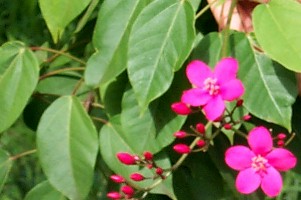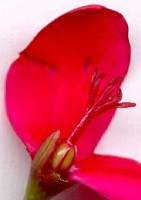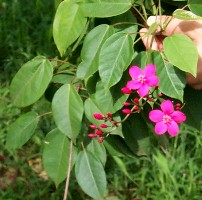Jatropha integerrima
Tree has both "male" and "female" flowers on the same tree.







Location collected: Nanmadol (Dolonier) Nett.
Date collected: November 27, 1999
Collected by: Eugene Joseph
- Genus species:Jatropha integerrima
- Family:
- Chuukese name:
- English name: Rose flowered jatropha
- Kosraean name:
- Pohnpeian name:
- Yapese name:
- Growth form: Shrub
- Growth location: Terrestrial
- Growth envionment: Cultivated garden
- Growth zone: Tropical
- Average height: 3-5 meters
- Stem: woody
- Leaf arrangement: Simple and fascicled
- Stipule: Absent
- Petioles: 1.0-3.0 cm long
- Leaf blade: Ovate and elliptical, 5-10 cm long, accute tip, green, smooth and shinny
upper surface, pinnate venation, and margin is entire
- Inflorescence: Umbel, usually comprised of four to five flowers at a common base
- Florl bracts: none
- Flower: Rotationally symmetric, slaveform, red
- Calyx: Green, fused and reduced to acup-like structure surrounding the ovary
- Corolla: Fused red corrola with four lobes
- Stamens: 0.1-0.3 cm long, red, ten anthers and filaments
- Ovary: Both inferior and superior ovaries
- Style: A single red style about 1.0-3.0 cm long
- Fruit: none
- Seed: not observed at collection time
- Anything else: no strong odor, usually for decoration
- Cultural usage: use as an incredient of soap
"Contains potentially lethal toxin, curcin, which is a type of toxalbumin.
Toxalbumins cause bleeding lesions in the mouth, esophagus, stomach, and intestines.
The lesions resemble alkaline burns, though the onset is sometimes delayed several hours
after ingestion. Toxalbumins interfere with cell function and cause cell damage leading to
serious liver, kidney, adrenal, nerve damage, and sometimes death."
- Poisonous
Plants of Paradise: First Aid and Medical Treatment of Injuries from Hawai'i's Plants.
Susan Scott and Craig Thomas, M.D.©2000. ISBN 0-8248-2251-X.
Botany home page
Lee Ling home
COM-FSM home page













